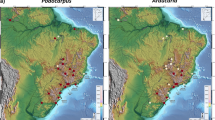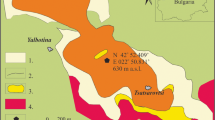Abstract
The role that climate plays in influencing the physiognomy of modern and fossil plant communities is widely acknowledged and forms the basis for several palaeoclimate proxies. In this work, both univariate Leaf Margin Analysis and multivariate Climate/Leaf Analysis Multivariate Program (CLAMP) were used for the climatic reconstruction of two fossil localities of the Atotonilco El Grande Formation. Using the predominantly North American and Asian calibration data set PHYSG3BRC, supplemented with new African material, results from two sites, Los Baños (present position 20°18′18″N, 98°42′44.4″W) and Sanctorum (20°18′18.5″N and 98°46′52.2″W), indicate that during the Pliocene a mesothermal climate existed with mean annual temperatures between 12 and 22°C, with the most likely being approximately 15°C, and a mean annual temperature range of 21°C. A distinct seasonal variation in rainfall is evident with a mean annual relative humidity of 60–70%. Differences between the sites can be explained by differences in depositional regime and spatial heterogeneity in the predominantly Quercus-dominated woodland. The continuous subsequent uplift of the Sierra Madre Oriental, the resulting development of a rain shadow, and the eventual disappearance of a palaeolake appear to have caused a transition to the modern xerophytic shrub vegetation.








Similar content being viewed by others
References
Ackerly DD, Dudley SA, Sultan SE, Schmitt J, Coleman JS, Linder CR, Sandquist DR, Geber MA, Evans AS, Dawson TE, Lechowicz MJ (2000) The evolution of plant ecophysiological traits: recent advances and future directions. BioSci 50:979–995
Arellano GJ, Velasco-de León MP, Salvador R, Silva PA, Beltràn RF (2005) Origen y características geológicas del paleo-lago de Amajac, Hidalgo. Rev Mex Cienc Geol 22:199–211
Bailey I, Sinnott E (1915) A botanical index of Cretaceous and Tertiary climates. Science 41:831–834
Bailey I, Sinnott E (1916) The climatic distribution of certain types of angiosperm leaves. Am J Bot 3:24–39
Burnham RJ, Pitman NCA, Johnson RK, Wilf P (2001) Habitat-related error in estimating temperatures from leaf margins in a humid tropical, forest. Am J Bot 88:1096–1102
Caballero M, Khursevich G, Velasco de Léon MP (2009) Tertiarus hildalgensis, A new diatom from Neogene deposits in Central México. Diatom Research 24:23–33
Calvillo-Canadel L, Cevallos-Ferriz SRS (2005) Diverse assemblage of Eocene and Oligocene leguminosae from Mexico. Int J Plant Sci 166(4):671–692
Cantagrel JM, Robin C (1979) K-Ar dating on eastern Mexican volcanic rocks. Relations between the andesitic and the alkaline provinces. J Volcanol Geoth Res 5:99–114
Cavalier C, Cháeteauneuf JJ, Pomero C, Rabussier D, Renard M, Vergnaud-Grazzini C (1981) The geological events at the Eocene/Oligocene boundary. Palaeogeogr Palaeoclimatol Palaeoecol 36:223–248
Cevallos-Ferriz SRS, Barajas-Morales J (1994) Fossil Woods from the el Cien Formation in Baja California sur: Leguminosae. IAWA J 15:229–245
Dolph GE, Dilcher DL (1980) Variation in leaf size with respect to climate in Costa Rica. Biotropica 12:91–99
Garcia E (1988) Modificaciones al Sistema de Clasificación Climática de Köpen. Instituto de Geografia, UNAM, Mexico
Givnish TJ (1984) Leaf and canopy adaptations in tropical forest. In: Medina E, Mooney HA, Vázquez-Yáñez C (eds) Biological diversity in México: origins and distribution. Oxford University Press, Oxford, pp 109–127
Gradstein FM, Ogg JG, Smith AG (Editors) (2005) A geologic time scale 2004. Cambridge, Cambridge University Press p 610
Graham A (1976) Studies in neotropical paleobotany II. The Miocene communities of Veracruz, Mexico. Ann Mo Bot Gard 63:787–842
Graham A (1999) The Tertiary history of the northern temperate element in northern Latin American. Am J Bot 86:32–38
Graham A, Palacios Chávez R (1996) Additions and preliminary study of an Oligocene-Miocene palynoflora from Chiapas, México. Rheedea 6:1–12
Gregory KM (1996) Are palaeoclimate estimates biased by foliar physiognomic responses to increased atmospheric CO2? Palaeogeogr Palaeoclimatol Palaeoecol 124:39–51
Hellicker BR, Richter SL (2008) Subtropical to boreal convergence of tree-leaf temperatures. Nature 454:511–514
Herman AB, Spicer RA (1996) Paleobotanical evidence for a warm Cretaceous Arctic Ocean. Nature 380:330–333
Hernández-Castillo G, Cevallos-Ferriz SRS (1999) Reproductive and vegetative organs with affinities to Halogaraceae from the Upper Cretaceous Huepac chert locality of Sonora, México. Am J Bot 86:1717–1723
Kennedy EM, Spicer RA, Rees PM (2002) Quantitative paleoclimate estimates from Late Cretaceous and Paleocene leaf floras in the northwest of the South Island, New Zealand. Palaeogeogr Palaeoclimatol Palaeoecol 184:321–345
Kowallis BJ, Carl CS, Carranza-Castañeda O, Millar WE, Tingey DG (1998) Fission-track and single-crystall40Ar/39 laser-fusion ages from volcanic ash layers in fossil-bearing Pliocene sediments in Central México. Rev Mex Cienc Geol 15(2):157–160
Lande R, Arnold SJ (1983) The measurement of selection on correlated characters. Evolution 36:1210–1226
López TB, Caballero M, Velasco-de León MP (2004) Diatomeas del Paleolago de Amajac., VXI Congreso Mexicano de Botánica, Oaxaca, México
Lugo-Hubp J (1990) El relieve de la República Mexicana. Inst Geol Rev 9:82–111
Magallon-Puebla S, Cevallos-Ferriz SRS (1994) Eucommia constans n sp. Fruits from upper Cenozoic strata of Puebla, Mexico: morphological and anatomical comparison with Eucommia ulmoides Oliver. Int J Plant Sci 155:80–95
Martínez-Hernández E (1992) Caracterización ambiental del Terciario de la región de Ixtapa, estado de Chiapas—un enfoque palinoestratigráfico. Inst Geol Rev 10:54–64
Martínez-Hernández E, Ramírez AE (1996) Palaeocorología de angiospermas de la flora mexicana durante el Mesozoico y Terciario. Algunas evidencias palinológicas. Bol Soc Bot México 58:87–97
Miranda F (1963) Two plants from the amber of the Simojovel, Chiapas, Mexico, area. J Paleontol 37:611–614
New M, Hulme M, Jones P (1999) Representing Twentieth-Century space–time climate variability. Part I: Development of a 1961–90 mean monthly terrestrial climatology. J Climate 12:829–856
Ortiz ME, Velasco-de León MP (2006) Cercocarpus leaves in the sediments of Tertiary of Santa Maria Amajac, Hidalgo, México. Advances in Paleobotany. Recognizing the contribution of David L. Dilcher and Jack a. Wolfe on the occasion of their 70th year. Gainesville, Florida
Palacios Chávez R, Rzedoswki J (1993) Estudio palinológico de las floras fósiles del Mioceno inferior y principios del Mioceno Medio de la región de Pichucalco, Chiapas, Mexico. Act Bot Mex 24:1–96
Ramírez JL, Cevallos-Ferriz SRS (2000a) Consideraciones sobre las Angiospermas (Plantas con flor) fósiles en México. GEOS Unión Geofís Mex 20:433–444
Ramírez JL, Cevallos-Ferriz SRS (2000b) Reconstruction of the leaves of two new species of Pseudoesmodingium (Anacardiacea) from Oligocene strata of Puebla, México. Int J Plant Sci 161:509–519
Ramírez JL, Cevallos-Ferriz SRS (2002) A diverse assemblage of Anacardiaceae from Oligocene sediments, Tepexi de Rodríguez, Puebla, México. Am J Bot 89(3):535–545
Rodríguez de la Rosa R, Cevallos-Ferriz SRS (1994) Upper Cretaceous zingiberalean fruits with in situ seeds from southeastern Coahuila, Mexico. Int J Plant sci 155:786–805
Sear CB, Kelley PM (1980) Eruption of Mt St Helens: effects on climate. Nature 285:533–535
Spicer RA (1977) The pre-depositional formation of some leaf impressions. Palaeontol 20:907–912
Spicer RA (2000) Leaf physiognomy and climate change. In: Culver SJ, Rawson P (eds) Biotic response to global change: the last 145 million years. Cambridge University Press, Cambridge, pp 244–264
Spicer RA (2007) Recent and Future Developments of CLAMP: Building on the Legacy of Jack A. Wolfe. Cour Forsch-Inst Senckenberg 258:109–118
Spicer RA (2008) CLAMP. In: Gornitz V (ed) Encyclopedia of paleoclimatology and ancient environments. Springer, Dordrecht, pp 156–158
Spicer RA, Herman AB, Kennedy EM (2005) The sensitivity of CLAMP to taphonomic loss of foliar physiognomic characters. Palaeogeogr Palaeoclimatol Palaeoecol 184:321–345
Spicer RA, Valdes PJ, Spicer TEV, Craggs HJ, Srivastava G, Mehrotra RC, Yang J (2009) New developments in CLAMP: calibration using global gridded meteorological data. Palaeogeogr Palaeoclimatol Palaeoecol 283:91–98
Stranks L, England P (1997) The use of a resemblance function in the measurement of climatic parameters from the physiognomy of woody dicotyledons. Palaeogeogr Palaeoclimatol Palaeoecol 131:15–28
ter Braak CJF (1986) Canonical Correspondence Analysis: a new eigenvector technique for multivariate direct gradient analysis. Ecology 67:1167–1179
Uppala SM et al (2005) The ERA-40 re-analysis. Q J Roy Meteorol Soc 131:2961–3012
Velasco-de León MP (1999) Estudio paleoecológico de una comunidad del Terciario en el estado de Puebla. Dissertation, Universidad Nacional Autónoma de México, México
Velasco-de León MP (2006) El género Quercus en el Plioceno de Santa María Amajac, Hidalgo, México., IX Congreso Latinoamericano de Botánica. República Dominicana Libro de Resúmenes, Santo Domingo
Velasco-de León MP, Cevallos-Ferriz SRS (1998) Leaves of Karwinskia axamilpense n.sp. (Rhamnaceae) from Oligocene sediments, near Tepexí de Rodríguez, Puebla, México. Can J Bot 76:410–419
Webb LJ (1959) Physiognomic classification of Australian rain forest. J Ecol 47:551–570
Wilf P (1997) When are leaves good thermometers? A new case for leaf margin analysis. Paleobiology 23:373–390
Wilf P, Wing SL, Greenwood DR, Greenwood CL (1998) Using fossil leaves as paleoprecipitation indicators: an Eocene example. Geological 26:203–206
Wolfe JA (1977) Paleogene floras from the Gulf of Alaska region. US Geol Surv Prof Pap 997:1–108
Wolfe JA (1979) Temperature parameters of humid to mesic forests of Eastern Asia and relation to forests of other regions of the Northern Hemisphere and Australasia. US Geol Surv Prof Pap 1106:1–37
Wolfe JA (1985) Distribution of major vegetational types during the Tertiary. In: Sundquist ET, Braecker WS (eds) The carbon cycle and atmospheric CO2: natural variations Archean to Present. Geophysics Monographs 32. American Geophysical Union, Washington, DC, pp 357–375
Wolfe JA (1993) A method of obtaining climatic parameters from leaf assemblages. US Geol Surv Bull 2040:1–73
Zaragoza-Caballero S, Velasco-de León MP (2004) Una especie nueva de Epicauta (Coleoptera: Meloidae) del Plioceno del Estado de Hidalgo, México. Rev Mex Cienc Geol 20:154–159
Acknowledgements
We thank Drs Elizabeth Kennedy and Dieter Uhl for their thoughtful, helpful and constructive comments during the review process. The first author is grateful for financial support from the Dirección General de Asuntos de Personal Académico (DGAPA-UNAM) IN100102-2 and IN108706. The third author thanks the Palaeontological Science Trust (PAST) and the South African NRF for fieldwork funding and financial support.
Author information
Authors and Affiliations
Corresponding author
Rights and permissions
About this article
Cite this article
Velasco-de León, M.P., Spicer, R.A. & Steart, D.C. Climatic reconstruction of two Pliocene floras from Mexico. Palaeobio Palaeoenv 90, 99–110 (2010). https://doi.org/10.1007/s12549-010-0022-4
Received:
Revised:
Accepted:
Published:
Issue Date:
DOI: https://doi.org/10.1007/s12549-010-0022-4




